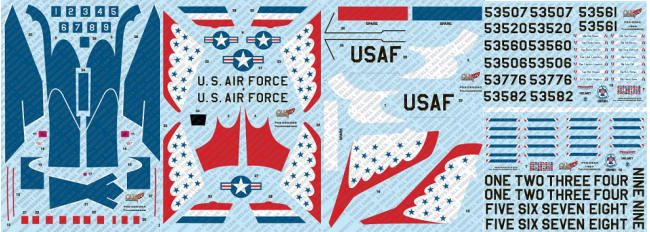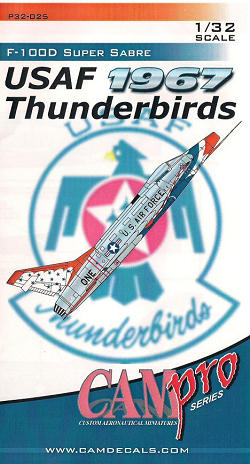
CAM Decals PD32-025/026: Thunderbirds F-100D 1965 and 1967 Seasons
| Unit(s): | USAF Thunderbirds |
| PRICE: | $45.00 per set |
| REVIEWER: | Ben Brown |

 Even
though it played a major role in the early days of the air war in Vietnam, the
F-100 is probably best-remembered by the general public as the mount of the
USAFís Thunderbirds and Skyblazers.
The F-100 was the first supersonic
aircraft the teams flew.
The Thunderbirds received six
F-100Cs straight off the production line in 1956 and except for borrowing some
F-100Ds for the 1959 Far East Tour, continued to fly the C until the end of the
1963 season.
In 1964, they switched to the
F-105B, but an accident and then delays getting the Thunderchiefs further
modified led to a return to the Super Sabre for the remainder of the season.
The team flew the F-100D from this
time until they gave them up for the F-4E for the 1969 season.
Even
though it played a major role in the early days of the air war in Vietnam, the
F-100 is probably best-remembered by the general public as the mount of the
USAFís Thunderbirds and Skyblazers.
The F-100 was the first supersonic
aircraft the teams flew.
The Thunderbirds received six
F-100Cs straight off the production line in 1956 and except for borrowing some
F-100Ds for the 1959 Far East Tour, continued to fly the C until the end of the
1963 season.
In 1964, they switched to the
F-105B, but an accident and then delays getting the Thunderchiefs further
modified led to a return to the Super Sabre for the remainder of the season.
The team flew the F-100D from this
time until they gave them up for the F-4E for the 1969 season.
When Trumpeter released their 1/32 F-100D, it was only a matter of time
before somebody released some Thunderbirds decals to go with it.
The F-100D is not one of
Trumpeterís better kits, and the list of its accuracy issues is quite long (the
same applies to their 1/48 and 1/72 F-100 series), but that is beyond the scope
of this review.
Letís just say that the most
accurate F-100 kit available in any scale is still the good old 1980s-vintage
1/48 Monogram F-100D.
CAM has released two separate versions of their Thunderbirds decals,
each reflecting the differences between the markings for the 1965 and 1967
seasons.
The most obvious was the change
from the last five digits of the serial number on the aft fuselage to the jetís
position number (ONE for Lead, TWO for Right Wing, etc.).
This occurred sometime between
mid-September and October 1965.
Another minor change was the style
of the crew name blocks on the canopy rails.
Hereís what you get:
∑
Complete markings to build any of the F-100Ds the
team flew during the 1965 or 1967 season (depending on which decal set you buy).
All the modeler has to do is paint
the natural metal areas and the decals will take care of almost all of the
color. There are blocks of red, blue, and white provided for touch-ups.
∑
Pilot and crew chief name
blocks for each jet.
∑
CAM is the first decal company Iíve seen that got
the blue nose scallops right, where the two points in front of the windscreen
aim at the panel lines below the windscreen, instead of at the windscreen frames
themselves, like on the Monogram kitís decals.
∑
Stripes for the inflight
refueling probe.
∑
A small separate sheet containing a finely-printed
flag panel and Thunderbirds badge was printed by Draw Decals using their
ďDigital SilkĒ process.
This is supposed to give a much
higher level of detail than screen-printed decals can achieve.
The
downside to this type of decal is the ink tends to be very stiff, so they will
not respond to setting solutions, and do not conform well to compound curves.
Iíve had all kinds of trouble
trying to apply this type of decal in the past, even when following the
manufacturerís instructions.
Digital Silk decals do work well
for relatively flat surfaces, and since they will be applied to the F-100ís
nose, where there isnít much curvature, they should be just fine.
Just dip them in
very hot
water before you apply them.
Based
on my past experiences, I wouldnít expect them to settle down into the
underlying rivets or panel lines, though.
∑
The colors seem spot-on.
One reference has stated that the
Thunderbirds red was assigned its own FS number, but Iíve never been able to
find anything but Insignia Red for the F-100.
∑
The national insignia and USAF for the wings are
undersized by about 2mm.
The national insignia was 35Ē and
the USAF was 30Ē, according to T.O. 1-1-4.
∑
According to T.O. 1-1-4,
the USAF and U.S. AIR FORCE should be Insignia Blue, instead of black.
∑
The letters for the U.S. AIR FORCE decals are a
little too thin.
∑
The outline for the single point fuel system access
panel under the trailing edge of the left wing has a FIRE ACCESS stencil in it.
Just
cut the stencil out of the center of the decal and donít put one on the right
side of the model.
∑
The little red circle
(Decal 17) doesnít appear in any F-100 photos I have.
∑
The serial numbers and position numbers (i.e., ONE,
TWO) are too large by a couple of mm.
They were 12Ē.
∑
If Trumpeter ever gets around to releasing the
much-promised F-100F, the nose scallops for the D won't fit, due to the F's
longer nose.
∑
The red tail scallops for the F-100D wonít work for
the F-100C. The F-100Cís tail was smaller and the style of the scallops was
different.
The F-100C also had three different
star sizes on the tail and stabilators.
∑
The tail of the #4 jet
was never painted black, and the blackened tail was considered a badge of honor.
In some photos, you can see the stars peeking out from under the soot,
especially down close to the fuselage.
∑
The F-100Dís smoke probe piping exited the fuselage
below the spine, just aft of the point where the removable section of the aft
fuselage breaks from the forward section.
It ran down the base of the fin,
with a little kink to allow the drag chute door on the base of the fin to open,
then continued aft to the afterburner nozzle.
∑
On the F-100D, the guns and gun sight was removed,
but the holes for the gun muzzles were not covered, so just omit the guns and
donít plug the holes.
On the F-100Cs, these were faired
over.
∑
Every other petal on the
afterburner nozzle was polished, not painted, which gave it the striped
appearance.
∑
There is a tendency for F-100D and F modelers to
put the USAF and national insignia too far outboard on the wings, so the wing
fences cut across them.
They were actually placed so
everything was inboard of the wing fences.
October 2011
Disclaimer:
Review decals were kindly loaned to
me by Ray Byers, of CAM Decals
http://www.camdecals.com/
If you would like your product reviewed fairly and fairly quickly, please contact the editor or see other details in the Note to Contributors.
Back to the Decal Review Index Page